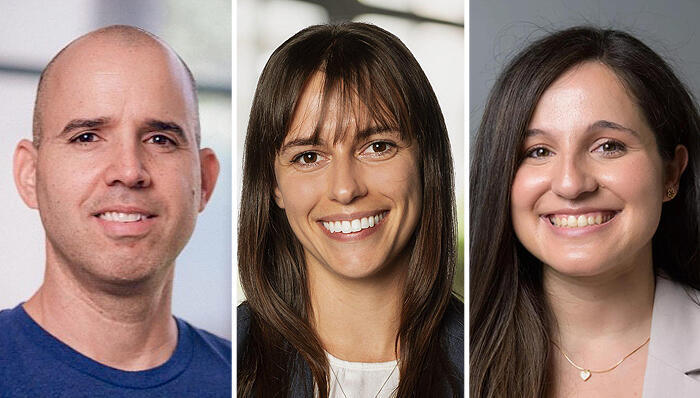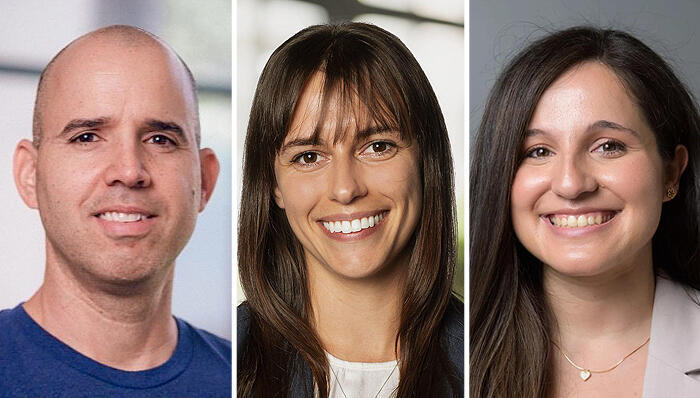“I want to see drugs that make sense”: Why women’s health should be taken seriously b

“I want to see drugs that make sense,” says Anastasia Budinskaya, Bio Associate at Israeli-American early-stage venture fund NFX. “I want the first-line therapy for women not to be asked, ‘Do you want to take your uterus out?’ or ‘Do you want to have surgery?’ I want there to be an opportunity to have a drug for endometriosis, for example, that doesn’t put you into menopause.”
Despite a market that represents over half of the world’s population, women’s health is a sector that has historically been overlooked, resulting in a desert of options for women, from enduring extreme side effects in contraception to facing the surgical knife for lack of viable alternatives. The sector has long been treated as peripheral to mainstream biotech and venture investment, with most femtech funding concentrated in fertility.
1 View gallery


Omri Drory Ph.D. Anastasia Budinskaya Dr Karny Ilan MD
(Credit: N/A, NFX Website, Fusion VC)
“Women aren’t just uteruses,” says Budinskaya. Born in Israel and growing up between Russia and the United States, Budinskaya trained as a biomedical engineer and spent her career across clinical and corporate development before moving into venture and joining NFX’s bio team. She continues: “Our lives don’t just revolve around having children and being able to or not being able to have children… We have all these other things that happen in our biology that we should care about.”
Budinskaya lists focus areas including PCOS, endometriosis, preeclampsia, osteoporosis and heart disease, all conditions that either affect only women or affect them differently. “We know that most people who are diagnosed with osteoporosis are women, and we know that heart disease affects women significantly differently, and heart attacks are expressed in women differently,” she says.
A tipping point, however, appears to be emerging as the correction of latent biases such as “the exclusion of women from clinical trials,” says Drory, together with advances in technology, precision medicine, and new computational and data collection methods, is validating the growing realization that women’s health is, in fact, worth investing in. Ethics aside, the commercial case is one that’s hard to shirk.
“Personally, I feel like I have a moral obligation,” says Budinskaya. “But it’s also a sector that’s going to provide returns.”
“This is not a special treatment for women,” says Drory, an Israeli-born scientist who relocated to the Bay Area after building and exiting his own biotech company, and now manages part of NFX Bio’s $1.4 billion portfolio. “I like to say I’m not a racist, I’m not a sexist, I’m a capitalist. Whatever makes me money, I’m happy.” He continues: “There is a lot we can do now in this space, which is again a huge market and a very important one.”
In Tel Aviv, CEO Dr. Karny Ilan, a surgeon by training, co-founded Feminai in 2023 to develop an AI-powered, at-home breast cancer screening device that enables women to self-examine using wearable sensors. Breast cancer is one of the most common cancers in women, and screening is among the most common exams they undergo during their lifetime. “So we wanted to create an easy, accurate and accessible alternative,” she says.
In Ilan’s experience, “When I go and raise money, I hate the words femtech and women’s health. I never try to categorize myself under those, because from what I’ve experienced, it always works badly.” She continues: “What I found as a founder is that when I stepped out and removed those hashtags of femtech and women’s health, it worked to my benefit.”
Furthermore, all the money the company has raised so far, Ilan notes, is from general investors, not from the funds that claim to dedicate their focus to women’s health. “I rarely see investments that are risky in really big fields, in big solutions that could lead somewhere,” she says. “Usually these investors are the ones that are scared the most.”
Feminai has raised $8 million from ICI Fund, Fusion VC, Arben Ventures and Cactus Capital, and recently received $1.65 million from the Israel Innovation Authority. But the funding hasn’t come easy. Ilan recalls meeting investors who told her “the market is too small.” “It was crazy to me,” she says. “No, it’s not. You just can’t do math.” Specifically for Feminai’s product, she explains, “This is the most common exam all women do during their lifetime, and we’re 51% of the population. This is not a small market. This is a very, very big market.”
Meanwhile, off the back of the publication of Women’s Health 2.0, NFX launched a call for founders developing solutions in women’s health, which received “a deluge of interest,” Drory says. Shortly after, Cyclana Bio announced a £5 million pre-Seed round co-led by NFX and Eka Ventures to develop a fibrosis-to-regeneration approach for endometriosis. The level of response and inbound deal flow is, as Budinskaya describes, an example of the “huge economic opportunity” within the sector.
After years of underappreciation, there is a reason why the area is now gaining traction. Both Cyclana Bio and Feminai exemplify what Budinskaya describes as an inflection point for women’s healthtech, driven by the recent revolution in machine learning and AI. “There’s been this massive move to AI that’s been a long time coming,” she says. “This is where a gap can really be bridged within women’s health in basically all of the sectors, except for surgical tech. It’s just completely understudied.”
She continues: “If we combine real-world evidence with biology in a dish, we can find new drugs, new drug targets, new ways of treating disorders that have been historically understudied.”
While progress in women’s healthtech may finally be gathering speed, the road ahead remains long, with much that could test its pace. For entrepreneurs like Ilan, “it would do the most service to us if we wouldn’t have to sit in a room and convince people why it’s a good business opportunity,” she says. “Making it obvious that it’s a big market would really help us.”
For now, progress hinges on proving that women’s health can deliver blockbuster exits. “As somebody who’s starting to invest in this kind of emerging theme, we need to make sure that we make the right investments so their success will help enable the entire space,” says Drory. “Nothing will improve the future success of an industry more than a company you can point to and say, ‘You see this multi-billion-dollar company?’”
But as Budinskaya notes, it will take the entire tech ecosystem, from follow-up investors to regulators, to pick up where the venture funds leave off. “It’s going to take everyone,” she says. “It’s not just niche biotech investors.”
And for all the reasons of vested interest, whether to gain from the lucrative market that is women’s healthtech or to improve the quality of life for over half the population, Budinskaya says, “It should be a priority for everyone.”
link







